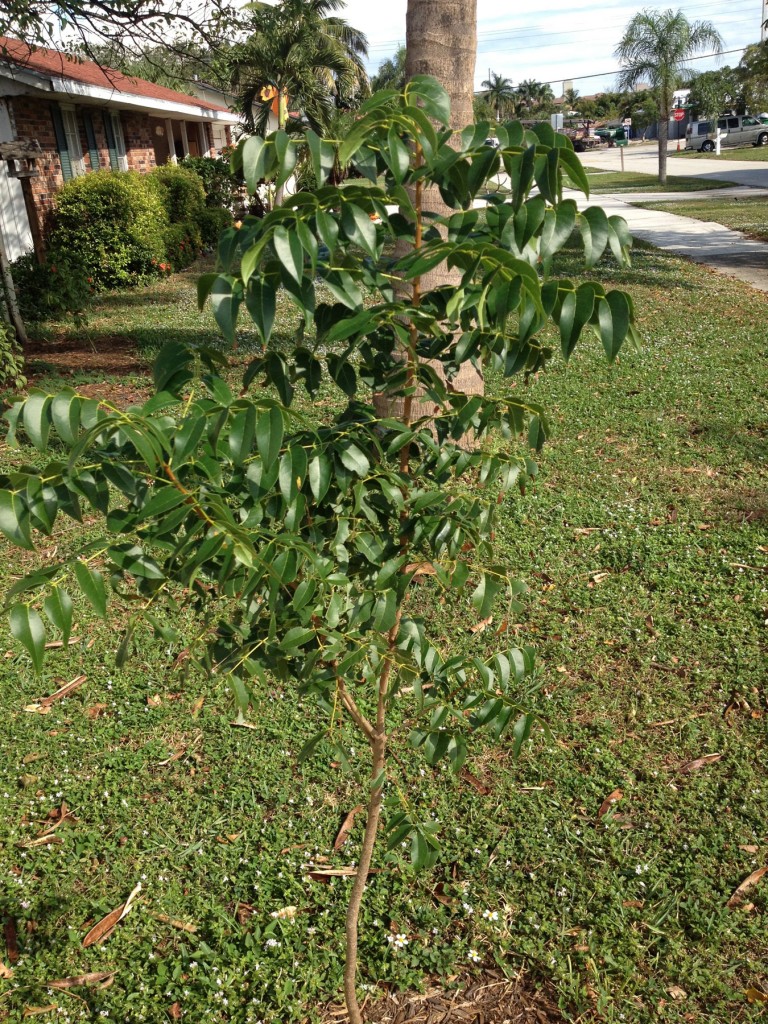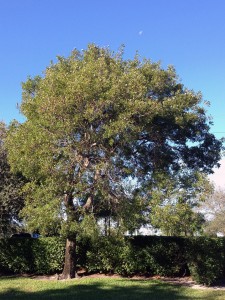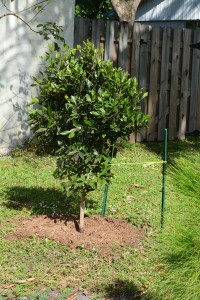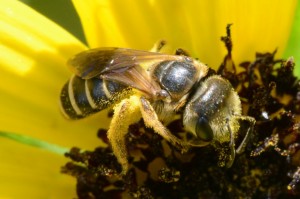The week before Thanksgiving 2013 was a busy one at the homestead. First, I found out that the “shrub” I transplanted from the old house and put right up next to the new house, counting on a nice upright slender shrub was in fact a West Indies mahogany tree that would have a crown width of 30-40 feet when mature. Whoops! So I had to move that baby away from the house. And of course it had just settled into the spot I’d originally transplanted it to; it had only been in the last two to three weeks that I’d started noticing some nice new growth and height.
Here’s how this little guy started:

And here’s how it’ll probably end up:

Most of the mahogany saplings that volunteer in people’s yards here in Boca Raton are offspring of the nursery-originated street trees that the city planted about thirty years ago along SW 4th Avenue and in other areas. Those trees were put in because mahogany was considered endangered at that point. Of course, that was back when the species approach to restoration was all people knew: if a species is endangered, propagate it. Now it’s recognized that even though a listed species might be desirable because of what it does for its native habitat, it’s the plant communities that grow up in that native habitat that provide the environmental and ecological benefits of that endangered species. There’s little point to planting a mahogany by itself if you’re trying to bring back the benefits of a mahogany hammock. You need the entire plant community that grows up in its shade. A wonderful example of that is at the aptly named Mahogany Hammock in Everglades National Park, where old-growth mahoganies have reached truly gigantic proportions and created a wonderful hammock community in their wake. Just watch out for the sap from the poisonwood trees (Metopium toxiferum) there; it can sometimes coat the benches and give unsuspecting visitors who sit or lie on them a severe rash, as I found out the hard way…
So anyway, I moved my mahogany away from the house:

That job done I started looking around to see what else needed doing and I cast my eye on the tightly planted area behind my giant American Beautyberry plant. I had planted a Pigeon-plum (Coccoloba diversifolia) on the east side of it and a blolly (Guapira discolor) and a crabwood (Gymnanthes lucida) too close together on the north. So it was time to thin out that little thicket and give each plant the room to grow it deserved.
The crabwood is a relatively large shrub or small tree, but it grows in a nice lollipop shape, about 25 feet tall max and maybe that much or less in crown. So as far as I can tell, the spot vacated by the mahogany, about 10 to 12 feet away from the house, would be perfect for it! So that’s where I wound up relocating that guy:

I suspect everyone will be happier now that there’s a bit less competition.
After that, there was no stopping me. I noticed that the group of Cordia globosa plants I’d tried to get to form a hedge up under the front windows never really took off in that full sun location. I’m surprised that they didn’t do well there; they’re supposed to be full sun plants. But now that I think about it, the best plants I have of this species are the ones growing in the more protected areas of my yard, half sun at most. In those situations they seem to grow quite vigorously, but out there with full sun all day long they just sort of tried and died. I eventually gave it up as a bad job and ripped them out.
Next weekend I’m going to replace them with dwarf strong bark (Bourreria cassinifolia) which, while not quite as formal a hedge as I’d been thinking of (as if C. globosa were!), should be perfect for that location, and at least as attractive to butterflies and other pollinators as the previous tenants of that spot.
To get ready for those newcomers, after I ripped out the old shrubs I laid down 20 bags of melaleuca mulch—literally laid them down still in the unopened bag over the bare soil, so that nothing will grow there for the week or so that the bare dirt is showing. Then, after I plant the newcomers next week, I’ll just pop open the bags and voilà! instant mulched hedge.
While I was at the nursery buying the mulch Daniel and I noticed a couple of small pots of Dune Sunflower (Helianthus debilis) going begging, so I brought them hone and planted them in the area right behind my mail box that’s always been a bit lonely looking. I can’t wait for them to start spreading and bringing in the pollinators like this sweat bee (halictid species) from this spring:

Happy fun times, getting dirty and sweaty and making the place look nice.
